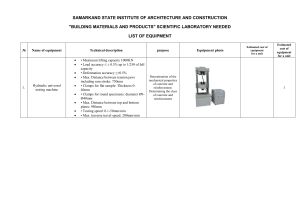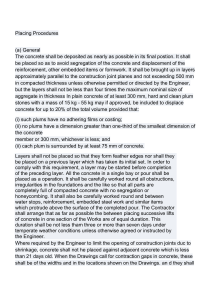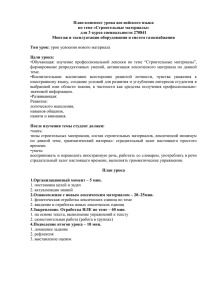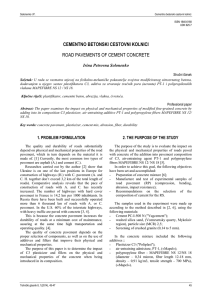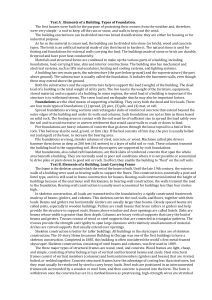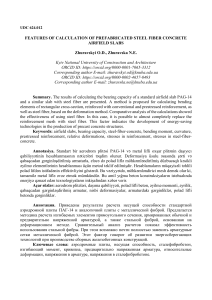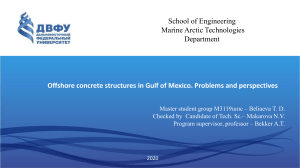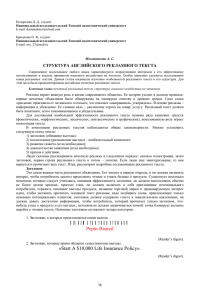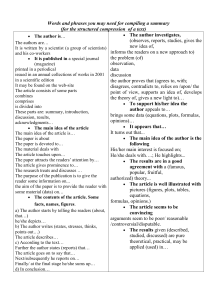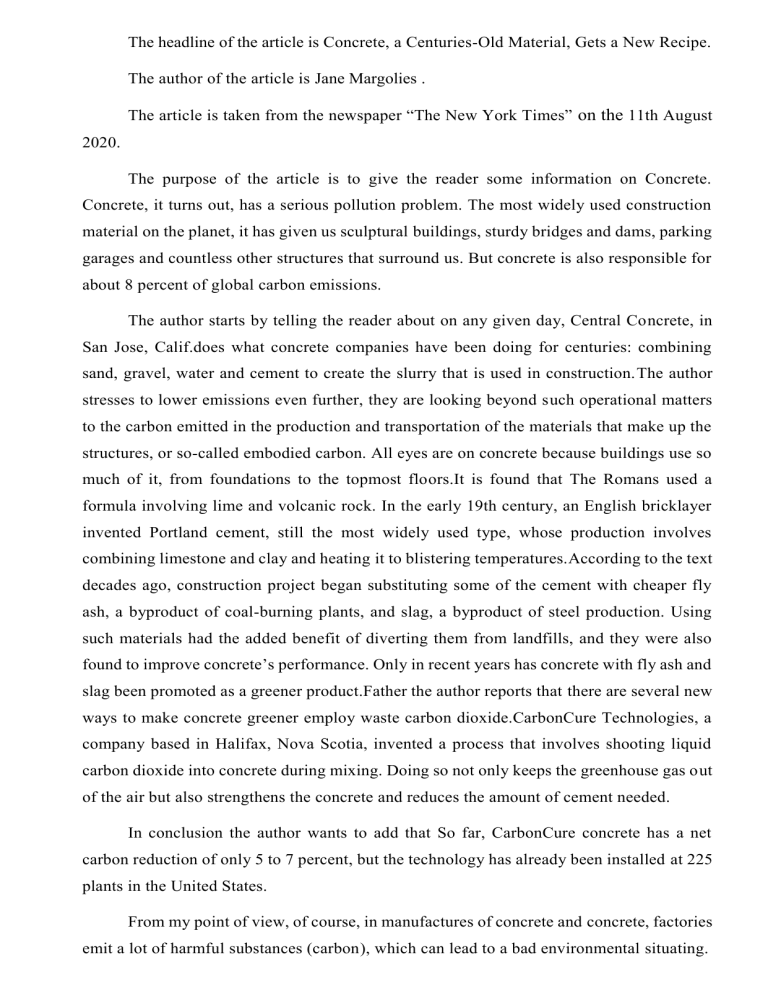
The headline of the article is Concrete, a Centuries-Old Material, Gets a New Recipe. The author of the article is Jane Margolies . The article is taken from the newspaper “The New York Times” on the 11th August 2020. The purpose of the article is to give the reader some information on Concrete. Concrete, it turns out, has a serious pollution problem. The most widely used construction material on the planet, it has given us sculptural buildings, sturdy bridges and dams, parking garages and countless other structures that surround us. But concrete is also responsible for about 8 percent of global carbon emissions. The author starts by telling the reader about on any given day, Central Concrete, in San Jose, Calif.does what concrete companies have been doing for centuries: combining sand, gravel, water and cement to create the slurry that is used in construction.The author stresses to lower emissions even further, they are looking beyond such operational matters to the carbon emitted in the production and transportation of the materials that make up the structures, or so-called embodied carbon. All eyes are on concrete because buildings use so much of it, from foundations to the topmost floors.It is found that The Romans used a formula involving lime and volcanic rock. In the early 19th century, an English bricklayer invented Portland cement, still the most widely used type, whose production involves combining limestone and clay and heating it to blistering temperatures.According to the text decades ago, construction project began substituting some of the cement with cheaper fly ash, a byproduct of coal-burning plants, and slag, a byproduct of steel production. Using such materials had the added benefit of diverting them from landfills, and they were also found to improve concrete’s performance. Only in recent years has concrete with fly ash and slag been promoted as a greener product.Father the author reports that there are several new ways to make concrete greener employ waste carbon dioxide.CarbonCure Technologies, a company based in Halifax, Nova Scotia, invented a process that involves shooting liquid carbon dioxide into concrete during mixing. Doing so not only keeps the greenhouse gas out of the air but also strengthens the concrete and reduces the amount of cement needed. In conclusion the author wants to add that So far, CarbonCure concrete has a net carbon reduction of only 5 to 7 percent, but the technology has already been installed at 225 plants in the United States. From my point of view, of course, in manufactures of concrete and concrete, factories emit a lot of harmful substances (carbon), which can lead to a bad environmental situating. The headline of the article is N.Y. Building Sites Reopen, Carefully, in Sing of Life Gearing Back Up. The author of the article is Matthew Haag. The article is taken from the newspaper “The New York Times” on the 28 April 2020. The purpose of the article is to give the reader some information on how the coronavirus pandemic has fundamentally changed the workplace in the nation’s largest city and the epicenter of the outbreak. The author starts by telling the reader about on the Far West Side of Manhattan, construction workers start every morning with a thermal forehead scan to take their temperatures. On service elevators at the high-rise development, they stand on floor markings to maintain social distancing. The author pointed out that across the city, laborers are wearing respiratory masks not only while working but also during breaks. They are disinfecting their tools, something rarely done before.Particular emphasis is placed on Governor Andrew M. Cuomo. He announced recently that the construction industry would be among the first categories of “low-risk” businesses allowed to return to normal as part of the state’s phased reopening scheduled to start as soon as mid-May. But some workers are dubious that work could soon resume safely.The paper reports that city’s Department of Building said inspectors were monitoring construction sites, making sure that workers at open sites were practicing social distancing and that those deemed nonessential remained closed.Much attention is given to new technologies on the construction site . Suffolk Construction Company is planning to roll out new technology at construction sites, including thermal scanners, which can remotely detect a fever in a worker without using a hand-held tool. Workers will also attach a device to their hard hats that will track their movements and sound an alarm when they get within six feet of a colleague. In conclusion the author wants to add that the company consulted with an engineering professor in Singapore, where the construction industry has used the remote temperature-taking devices. He says that we need something that given simultaneous results and fight in several directions. From my point of view, of course, the author of the article is completely right. With the arrival of a new disease, we must ensure the safety of employees in the construction industry, monitor their health, and develop new technologies to reduce the incidence of diseases in the world. The headline of the article is A 3D Print-Out You Could Call Home. The author of the article is Julie Lasky. The article is taken from the newspaper “The New York Times” on the 8 November 2019. The purpose of the article is to give the reader some information on using concrete and giant printers ,home building may one day be much faster and cheaper . The author starts by telling the reader about on the project, called TERA, is one of the latest experiments in 3D-printed houses. This 24-foot-high, 500-square-foot, two-story construction will have a sleeping pod, a bathroom with a shower, a study area.The author stresses that innovators in this arena are seeking to reduce the expense, environmental impact and hazards of construction methods that have remained fundamentally unchanged for more than a thousand years.According to the text architects and engineers are edging closer to this goal, by printing portions of houses and assembling or finishing them conventionally. They are testing different structural, surface and insulation materials and struggling to clear one of the highest bars in this technological obstacle course: the 3D-printed roof.Particular emphasis is placed on project. The company wanted to see how much force it would take to crush it. AI SpaceFactory is recycling the crushed material in TERA to demonstrate its commitment to zero waste. The vision is of an autonomous robot that collects, processes and prints what it finds.The paper reports that last year, the New Story organization unveiled a 350 square pound house in East Austin that had a conventional flat roof with standard materials. The house was printer by a Vulcan machine in 47 hours, and cost 10000 for printer elements.Further the author reports that in may, ICON and New Story again made news with their plans for a village of about 50 printed houses for a poor community in an undisclosed location in semirural Latin America. In conclusion the author wants to add that the Netherlands is developing various houses depending on the material and structural complexity, from a single-story print house to several floors. But the walls will be thickened to insulate and ventilate the material. From my point of view, of course, I fully agree with the author that 3d construction is the future. You can building in a short time with minimal labor. because all the work is done machines.

